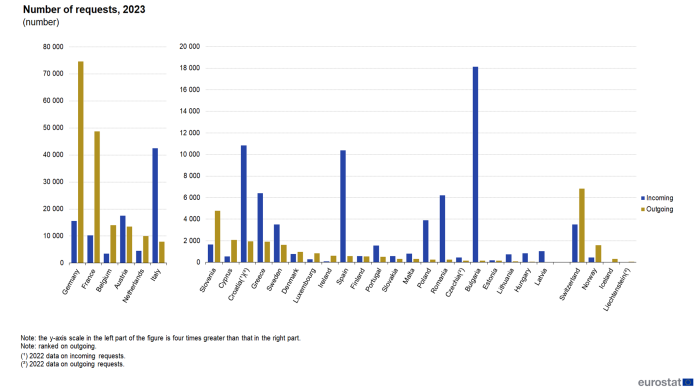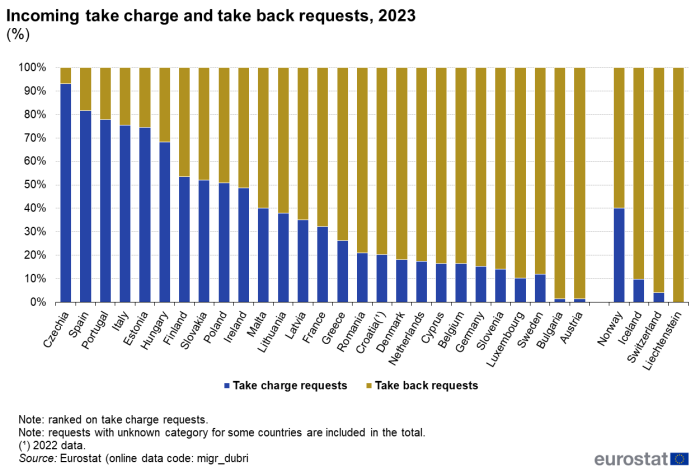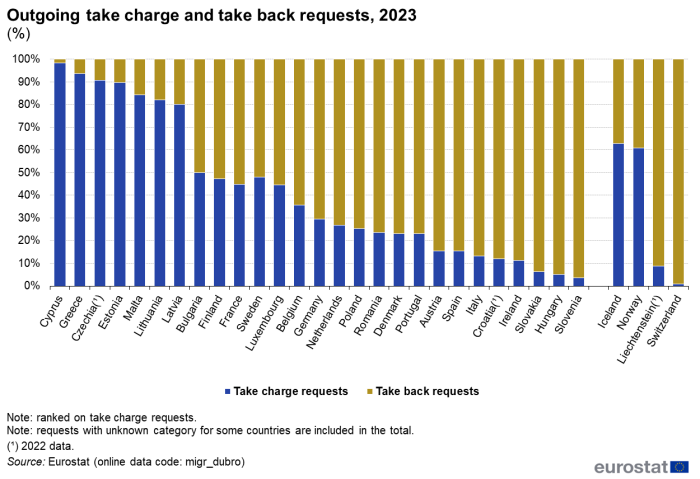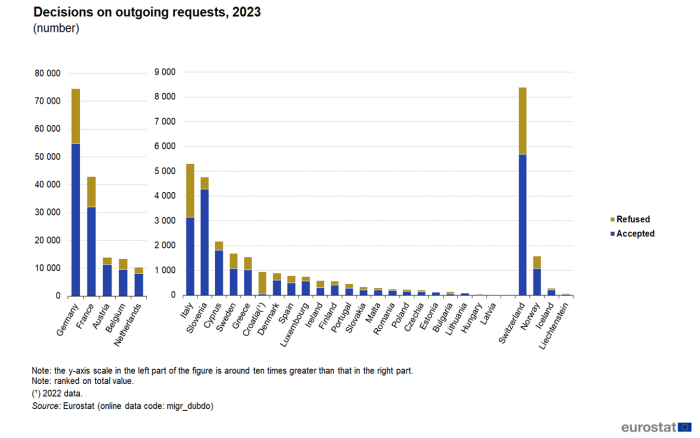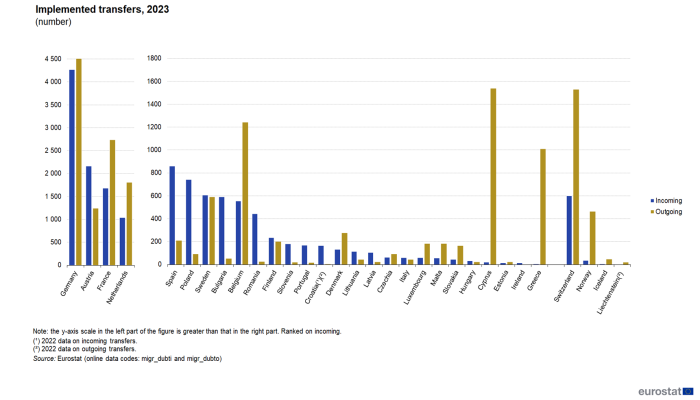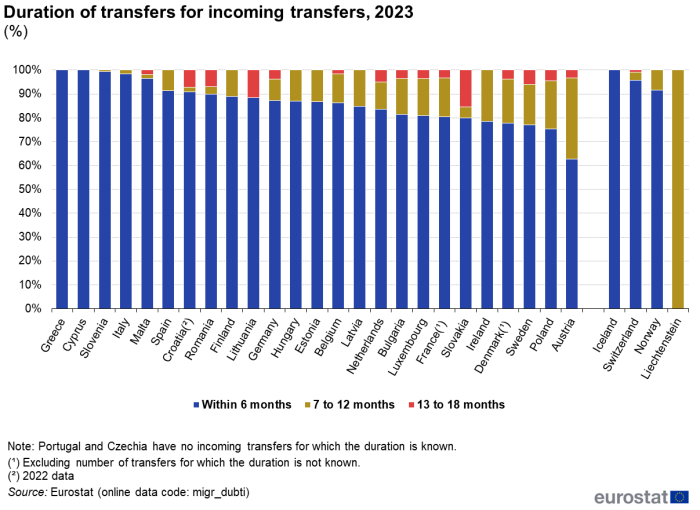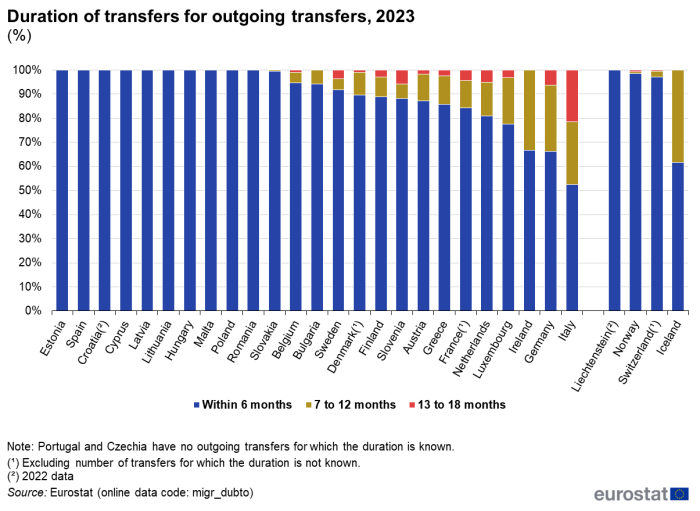Statistics on countries responsible for asylum applications (Dublin Regulation)
Data extracted in July 2024.
Planned article update: July 2025.
Highlights
In 2023, under the Dublin Regulation, Germany (74 620) and France (48 724) reported the largest number of outgoing requests to other EU countries; the largest number of incoming requests was recorded by Italy (42 468), followed by Bulgaria (18 145), Austria (17 476) and Germany (15 567).
In 2023, Germany (74 490) and France (42 862) received the largest number of decisions on their outgoing requests; Italy (42 753), Austria (18 652) and Bulgaria (18 644) made the largest number of decisions on incoming requests using the Dublin procedure.
In 2023, Germany and France recorded the largest number of transfers following the Dublin procedure: Germany reported 5 049 outgoing and 4 269 incoming transfers, while France reported 2 739 outgoing and 1 682 incoming transfers.
This article presents statistics on the implementation of Regulation (EU) No 604/2013 [1] (called hereafter 'Dublin Regulation') which aims at determining rapidly the EU country responsible for an asylum application and at preventing abuse of the system by the submission of several applications for asylum by one person. Data[2] are provided for EU countries and the European Free Trade Association (EFTA) countries.
The main principle is that only one EU country or EFTA country is responsible for examining an asylum application by a citizen of a non-EU country or by a stateless person. If during the course of the processing of an application the authorities in one EU country decide that the application should be dealt with in another EU country, the authorities of the former may make a request to the other EU country to take over responsibility of the asylum application (and consequently take over the applicant). Accordingly, the statistics refer to outgoing requests (EU countries reporting requests sent out) and incoming requests (EU countries reporting requests received).
Statistics presented in this article cover three main components related to the application of the Dublin Regulation: Dublin requests (initial requests), decisions on Dublin requests (positive and negative) and transfers following the acceptance of the requests. The purpose is to identify the EU country responsible for processing the asylum application based on specific criteria outlined in the regulation and potentially transferring the asylum seeker there.
This article describes the latest situation — data for 2023 — in relation to the numbers and types of requests. It also refers to subsequent stages in the procedure, namely decisions taken concerning requests, as well as any transfers of persons resulting from accepted requests to EU countries, which accepted the responsibility to examine applications. It is important to note that in this article, the term 'requests' refer specifically to requests of asylum seekers sent by a EU country to another EU country under the Dublin regulation, excluding re-examinations.
Full article
Dublin requests
Incoming and outgoing Dublin requests in 2023
In 2023, there were large disparities in incoming requests between EU countries (Figure 1), both in terms of how many requests were handled and in terms of the net requests received (the difference between the number of incoming and outgoing requests).
Five EU countries for which data are available sent out fewer than 200 outgoing requests in 2023: the three Baltic Member States (Estonia, Latvia and Lithuania), Bulgaria and Hungary. A total of ten EU countries sent between 200 and 1 000 requests, while six EU countries sent between 1 000 and 10 000 requests. By far the largest numbers of outgoing requests were sent by Germany (74 620) and France (48 724).
Italy received the largest number of incoming requests in 2023, a total of 42 468, followed by Bulgaria (18 145), Austria (17 476) and Germany (15 567). Ten EU countries for which data are available for the year 2023 received less than 1 000 requests, among which Ireland received fewer than 100 requests (76 requests).
When comparing the number of requests sent and the number of requests received, 16 EU countries received more requests in 2023 than they have sent. By contrast, nine EU countries sent more requests than they received.
Incoming take charge and take back requests
There are two types of requests, namely take charge or take back requests. In the case of the take charge requests, the requesting country (the one sending the request) considers that the other EU country (receiving the request) should take over responsibility for examining the asylum application of an individual. In the case of take back requests, the asylum seeker (who is in the requesting country) has already submitted an application for asylum in the country receiving the request.
In 2023, in 17 EU countries for which data are available there were more take back than take charge requests, while the reverse situation was observed in the remaining nine EU countries (Figure 2). The ratio of take back to take charge requests was particularly high in Austria and Bulgaria (74 and 67 take back requests for each take charge request) and to a lesser extent in Luxembourg (9:1), Sweden (7:1) and Slovenia (6:1). By contrast, more than 70 % of requests received in Czechia (93 %), Spain (81.6 %), Portugal (77.9 %), Italy (75.4 %) and Estonia (74.6 %) were take charge requests.
Reasons for incoming take charge and take back requests
The two pie charts in Figure 3 present the underlying reasons for taking charge or taking back requests. In 2023, the vast majority of incoming take charge requests received in EU countries were related to irregular entry (57.2 %), documentation and legal entry (37.7 %) and family reasons (3 %); together these three categories accounted for over 97 % of all take charge requests.
For incoming take back requests, the lack of permission to stay for an asylum applicant (no residence permit) accounted for 92.4 % of cases still under examination while 6.9 % had been rejected. The withdrawal of applications— either during the Dublin procedure or with new applications — made up only 0.5 % of cases.
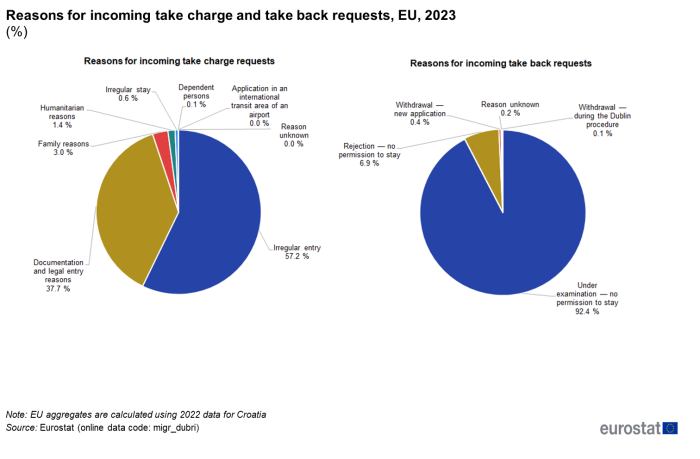
(%)
Source: Eurostat (migr_dubri)
Incoming requests by sex and by type of applicant
In 2023, in all countries for which data are available, the incoming requests mainly concerned males. In Bulgaria, Romania, Austria and Slovenia the share of requests related to males accounted for over 90 % (Figure 4). The greatest share of requests that related to females (over 35 %) were observed in Portugal and Czechia. Looking at the type of applicant (adults, accompanied and unaccompanied minors), in only four EU countries the share of incoming requests related to unaccompanied minors was above 5 %: Cyprus (11 %), Austria (9.7 %), Bulgaria (7.6 %) and Denmark (7.3 %).
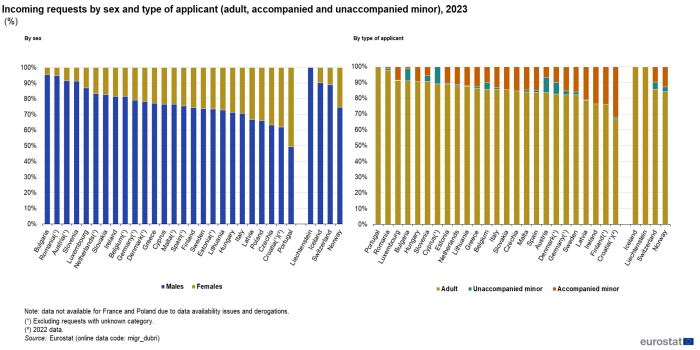
Source: Eurostat (migr_dubri)
Outgoing take charge and take back requests
In 2023, in 18 EU countries for which data are available there were more take back than take charge requests, while the reverse situation was seen in the remaining countries (Figure 5). The ratio of take back to take charge requests was particularly high in Slovenia (26:1), Hungary (19:1) and Slovakia (15:1). By contrast, 98.3 % of requests sent from Cyprus were take charge requests, with this share reached 93.6 % in Greece and Estonia 89.7 %.
Reasons for outgoing take charge and take back requests
In 2023, the vast majority of outgoing take charge requests sent by EU countries were related to irregular entry (53.9 %), documentation and legal entry (36.7 %); together these two categories accounted for 9 out of 10 (90.6 %) take charge requests (Figure 6). Nearly all outgoing take back requests sent were related to no permission to stay, either concerning applications under examination (92.1 %) or rejected ones (6.2 %).
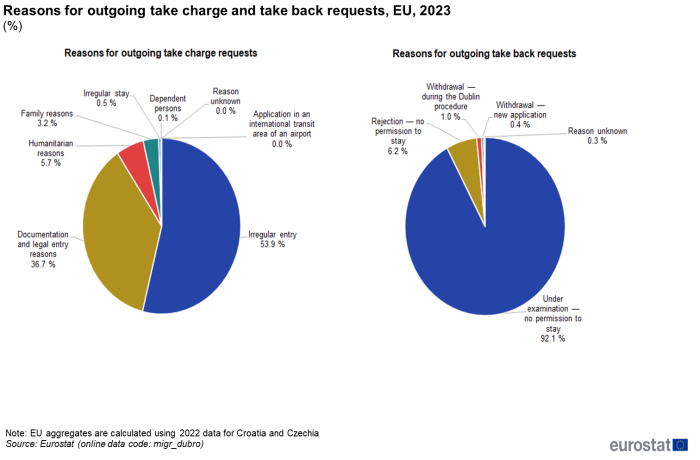
(%)
Source: Eurostat (migr_dubro)
Outgoing requests by sex and by type of applicant
In 2023, for countries for which data are available, outgoing requests concerned mostly males, with Hungary where there were no requests related to females (Figure 7). The greatest share of outgoing requests concerning females was observed in Latvia (40 %) followed by Poland and Greece. Looking at the type of applicant (adults, accompanied and unaccompanied minors), the share of outgoing requests related to unaccompanied minors was above 15 % only in three EU countries: Bulgaria (34 %), Cyprus (19.5 %) and Greece (15.6 %). In Greece, the share of requests that concerned minors (both accompanied and unaccompanied) accounted for 52.2 %, while in Bulgaria, Latvia and Italy it was respectively 44.7 %, 33.3 % and 24.2 %. In Portugal and Hungary, all the outgoing requests were for adults.

Source: Eurostat (migr_dubro)
Decisions on Dublin requests
Accepted and rejected decisions
The number of decisions on incoming or outgoing requests is related to the number of requests (excluding the re-examination requests), although the decision on a particular request may be made in a different calendar year, especially if decisions are delayed. Due to the relative volatility in the incoming and outgoing requests in EU countries in recent years (related to the volatility in the number of asylum applicants) there can be substantial differences between the number of requests and the number of decisions in a single reporting year. In 2023, for countries for which data are available, Italy (42 753), Austria (18 652) and Bulgaria (18 644) issued the largest number of decisions on incoming requests (Figure 8), with Italy accepting 85.3 % of the requests received, Austria 56.5 % and Bulgaria 73.2 %. A further 12 EU countries took more than 1 000 decisions on Dublin requests in 2023. Among the remaining 11 EU countries, Ireland took the fewest decisions (78).
Looking at decisions on outgoing requests in 2023 for countries for which data are available, Germany (74 490) and France (42 862) received the largest number of decisions on requests they have sent to other countries (Figure 9). A further eight EU countries received at least 1 000 decisions on their outgoing requests in 2023. The 16 remaining EU countries, received fewer than 1 000 decisions on their requests, while Latvia and Hungary received less than 100 decisions on their outgoing requests.
Implemented transfers
The final stage of the Dublin procedure, in case of acceptance of the request, is the actual transfer of the person from the requesting EU country to the EU country responsible.
In 2023, by far the largest number of incoming transfers was recorded by Germany (4 269), followed by Austria (2 166) and France (1 682). The largest numbers of outgoing transfers were reported by Germany (5 049) and France (2 739) followed by the Netherlands (1 807) and Cyprus (1 539) (Figure 10).
Figures 11 and 12 provide an analysis of the time taken for applicants to be transferred, based on the time lag between a decision being taken and the person actually being transferred. Data are compiled for three periods corresponding to the various possibilities for the timing of transfers as laid down in the Dublin III Regulation: the transfer of the applicant from the requesting EU country shall be carried out in accordance with the national law of the requesting EU country and at the latest within six months of acceptance of the request; this time limit may be extended up to a maximum of one year if the transfer could not be carried out due to the imprisonment of the person concerned or up to a maximum of 18 months if the person concerned absconds.
In 2023, in Greece and Cyprus all incoming transfers were completed within six months. In all the EU countries for which data are available, at least half of all incoming transfers were completed within six months. Austria had the greatest share of transfers completed between 7 and 12 months (34.1 %), while Slovakia and Lithuania had the largest shares of transfers completed between 13 and 18 months, respectively 15.6 % and 11.5 %.
For outgoing transfers (Figure 12) there were nine EU countries where all (100 %) outgoing transfers were implemented within six months. Italy reported the lowest share of outgoing transfers completed within six months (52.4 %) for its 42 outgoing transfers.
For more detailed information on implemented transfers by sex and type of applicant please refer to the Eurostat database.
Source data for tables and graphs
Data sources
The legal basis of data collection on migration and international protection (asylum) is Council Regulation (EC) No 862/2007 of 11 July 2007, which refers to the obligation to submit Dublin statistics (among other statistics on migration and international protection). The national data are provided by interior ministries (also known as ministries for internal or home affairs), statistical offices or agencies responsible for immigration.
Data are collected on an annual basis (calendar year) and must be transmitted by reporting countries no later than three months after the end of the reference period. The time series start with the 2008 reference year.
In relation to the new statistics by sex and by type of applicant presented in this article, derogations were granted to some EU countries based on Commission Implementing Decision (EU) 2021/431 of 10 March 2021.
Limitations on data availability affecting the information presented in this article:
- Data for incoming Dublin requests not available for Croatia 2023. Disaggregation by sex is not available for France. Disaggregation by type of applicant is not available for France and Poland.
- Data for outgoing Dublin requests not available for Czechia and Croatia 2023. Disaggregation by type of applicant is not available for Poland.
- Data for decisions on incoming Dublin requests not available for Croatia 2023.
- Data for decisions on outgoing Dublin requests not available for Croatia 2023.
- Data for incoming Dublin transfer not available for Croatia 2023. Disaggregation by duration is not available for Czechia and Portugal.
- Data for outgoing Dublin transfer not available for Croatia 2023. Disaggregation by duration is not available for Czechia and Portugal.
Data quality and comparability
Article 4.4 of Council Regulation (EC) No 862/2007 refers to statistics based on the number of requests. It is however recommended by Eurostat that data should be provided with respect to the number of persons concerned (by requests, decisions and transfers) as some requests may relate to more than one person. However, for technical reasons some countries supply statistics relating to the number of requests rather than persons.
Asymmetries exist between incoming requests received by one EU country and outgoing requests sent by another. Asymmetries may exist for a number of reasons.
EU countries may record requests at different times — a few days apart, which may lead to some small asymmetries between one reporting year and the next.
The initial reason for a request may be changed by the EU country receiving the request if its investigation of the request shows that there is a different basis for accepting the request than that proposed by the requesting EU country. Such changes in the nature of the requests may not be fully reflected in the statistics reported by the requesting and receiving EU country.
As noted above, some EU countries provide information for the number of requests and others for the number of persons and these differ in the case of multi-person requests.
Context
Background
Since 1999, the EU has been working towards creating a common European asylum regime in accordance with the Geneva Convention and other applicable international instruments. The Directorate-General Migration and Home Affairs (DG HOME) is responsible for developing EU policies on asylum. The main legal instruments on asylum, including the responsibility criteria determining the EU country responsible for assessing an asylum application, are:
- Asylum and Migration Management Regulation (EU) No 2024/1351 of the European Parliament and of the Council of 14 May 2024 on asylum and migration management, amending Regulations (EU) 2021/1147 and (EU) 2021/1060 and repealing Regulation (EU) No 604/2013;
- Eurodac Regulation (EU) No 2024/1358 of the European Parliament and of the Council of 14 May 2024 on the establishment of ‘Eurodac’ for the comparison of biometric data in order to effectively apply Regulations (EU) 2024/1351 and (EU) 2024/1350 of the European Parliament and of the Council and Council Directive 2001/55/EC to identify illegally staying third-country nationals and stateless persons and on requests for the comparison with Eurodac data by EU countries’ law enforcement authorities and Europol for law enforcement purposes, amending Regulations (EU) 2018/1240 and (EU) 2019/818 of the European Parliament and of the Council and repealing Regulation (EU) No 603/2013 of the European Parliament and of the Council;
- Asylum Regulation Procedure (EU) No 1347/2024 of the European Parliament and of the Council of 14 May 2024 on standards for the qualification of third-country nationals or stateless persons as beneficiaries of international protection, for a uniform status for refugees or for persons eligible for subsidiary protection and for the content of the protection granted, amending Council Directive 2003/109/EC and repealing Directive 2011/95/EU of the European Parliament and of the Council;
- Qualification Regulation (EU) No 2024/1348 of the European Parliament and of the Council of 14 May 2024 establishing a common procedure for international protection in the Union and repealing Directive 2013/32/EU;
- Reception Conditions Directive (EU) No 2024/1346 of the European Parliament and of the Council of 14 May 2024 laying down standards for the reception of applicants for international protection;
- Screening Regulation (EU) No 2024/1356 of the European Parliament and of the Council of 14 May 2024 introducing the screening of third-country nationals at the external borders and amending Regulations (EC) No 767/2008, (EU) 2017/2226, (EU) 2018/1240 and (EU) 2019/817;
- Union Resettlement Framework Regulation (EU) No 2024/1350 of the European Parliament and of the Council of 14 May 2024 establishing a Union Resettlement and Humanitarian Admission Framework, and amending Regulation (EU) 2021/1147.
These legal instruments were introduced by the Pact on Migration and Asylum which sets out new rules for managing migration and establishing a common asylum system at EU level. It builds on and amends previous reform proposals in the area of migration, offering a comprehensive approach that aims at strengthening and integrating key EU policies on migration, asylum, border management and integration.
In recent years, there has been an increase in demand for more detailed Dublin statistics. The amendment to Regulation (EC) No 862/2007 introduced additional dimensions by sex and by type of applicant. These additional data have been collected since the reference year 2021. Some EU countries have derogations regarding the provision of these new breakdowns[3].
On 10 April 2024, the European Parliament voted in favour of the new rules on migration, followed by their formal adoption by the Council of the EU, on 14 May 2024.
The Dublin Regulation
The Dublin Regulation (developed from the original Dublin Convention) establishes the EU country responsible for the examination of an asylum application. Regulation (EC) 2003/343 (known as Dublin II) replaced the 1990 Dublin Convention which first set the criteria relating to responsibility for processing an individual's asylum application. Dublin II remained valid until 1 January 2014, when Regulation (EU) No 604/2013, which was adopted on 26 June 2013, entered into force: it is known as Dublin III. All EU countries apply the Dublin Regulation, as do the EFTA countries. This Regulation was repealed by the Regulation (EU) 2024/1351 of the European Parliament and of the Council of 14 May 2024 on asylum and migration management, which will apply from 1 July 2026. Until this period, statistics will be collected on the basis of Regulation (EU) 604/2013.From the reference year 2026, the new Regulation will be used for the reporting.
The Dublin procedure establishes the principle that only one EU country is responsible for examining an asylum application. The objective is to avoid asylum seekers being sent from one country to another and also to prevent abuse of the system by the submission of several applications for asylum by one person. The criteria for establishing responsibility range, in hierarchical order, from family considerations, to recent possession of a visa or residence permit in a EU country, to whether the applicant has entered the EU irregularly or regularly.
In April 2016, the European Commission presented a Communication Towards a reform of the Common European Asylum System and enhancing legal avenues to Europe (COM(2016) 197 final). This was followed in May and July 2016 by two packages of proposals for reforming the common European asylum system. Part of the first package was a proposal for a reform of the Dublin Regulation (COM(2016) 0270 final/2). These proposals to introduce a new pact on migration and asylum aimed to improve and speed up procedures for the asylum and migration system, while promoting the fair sharing of responsibility and solidarity.
After intense, yet unsuccessful negotiations, the EU countries were unable to agree on a common approach and negotiations on the proposal for a reform of the Dublin Regulation stalled. In September 2020, the European Commission proposed to replace the Dublin III Regulation with a new Regulation on asylum and migration management (COM(2020) 610 final).
Direct access to
Notes
- ↑ This regulation, also known as the Dublin III Regulation, entered into force in January 2014 and it was repealed in June 2024 by Regulation (EU) No 2024/1351 on asylum and migration management. The Dublin III Regulation is the key legislation for the allocation of this responsibility. It is based on a hierarchical set of criteria, from family considerations, to recent possession of a visa or residence permit in an EU countries to whether the applicant has entered the EU irregularly or regularly. The Dublin III Regulation is complemented by the EURODAC Regulation (EU) No 603/2013 which established the use of an EU asylum fingerprint database, the EURODAC central system and which was also repealed in June 2024 by the Regulation (EU) No 2024/1351 on asylum and migration management.
- ↑ Data presented in this article refer to the geopolitical entity of the reporting country (GEO dimension in the online datasets) and are not to be confused with the data of the partner country involved (PARTNER dimension). For example, for Figure 1, the number of outgoing requests refers to the number of requests sent from the reporting country (to all partner countries), while the number of incoming requests refers to (incoming) requests received by the reporting country (from all partner countries).
- ↑ In relation to the Dublin statistics the following derogations were granted to the EU countries based on Commission Implementing Decision (EU) 2021/431 of 10 March 2021:
1) For disaggregation by accompanied and unaccompanied minors for all statistics
- Spain for the reference years 2021-2022
- Cyprus and Poland for the reference years 2021-2023
- France for the reference years 2021-2022
- Lithuania for the reference year 2021
- Malta for the reference years 2021-2022
- Sweden for the reference years 2021-2023
- Belgium for the reference years 2021-2022, Czechia and Cyprus for the reference years 2021-2023, Lithuania for the reference year 2021.
- Asylum applications - monthly statistics
- Asylum applications - annual statistics
- Enforcement of immigration legislation statistics
- Migrant integration statistics — online publication
- Migration and migrant population statistics
- Population and population change statistics
- Population statistics at regional level
- Residence permits — statistics on first permits issued during the year
- Asylum (migr_asy), see:
- 'Dublin' statistics (migr_dub)
- 'Dublin' requests (migr_dubreq)
- Decisions on 'Dublin' requests (migr_dubdec)
- Transfers (migr_dubtransf)
- Dublin statistics (ESMS metadata file — migr_dub_esms)
- Technical guidelines for the data collection under Art. 4.4 of the Regulation 862/2007 — Dublin statistics
